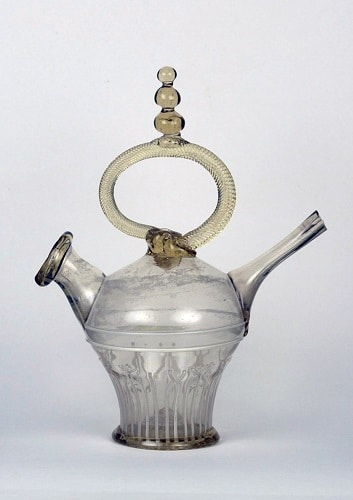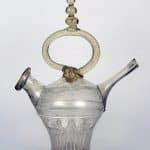Allaire Collection of Ancient Glass
When it comes to sharing information on the very foundation of glass form, function, and beauty, you would be hard-pressed to find a better resource than the Allaire Collection at ancientglass.wordpress.com
Once you arrive on the site, you will be amazed at the plethora of images, footnotes, articles, and more that will have you amazed at the feat of collecting and dedication laid out in front of you. The Allaires are a force within the world of Ancient Glass and thanks to their research, collecting, and viewing some of the best glass museums and exhibits in the world, we can all benefit and may find a new passion for not only antique glass, but Ancient glass, with a capital “A.” Here is our interview:
Carole Allaire: My husband and I have been collecting and studying ancient glass for the last twenty five years. Our interest spans nearly 3000 years of glassmaking from the Roman period to now. By historical periods and areas, it is: Roman glass, Frankish glass (Merovingian glass), Medieval glass, Venetian glass & Facon de Venise, European, English, Spanish and American. Most of the glass we focus on was made before 1850.
Each period of glass has its unique fascination and with every new piece we unlock the history of that era. It is mainly the beauty of the objects we are attracted to and with glass its color, clarity and form that makes them true works of art. Surrounding ourselves with these delicate beauties is what makes collecting them so addictive. To enhance our world of glass and share with other enthusiasts we have created a website showing our collection, other collections, and glass features.
What was the reason you started collecting?
We were highly attracted to the beauty of objects made of glass and how light was reflected in the glass. This is especially true of the modern studio glass.
What was your first piece and how did you come across it?
Our interest in glass started with modern studio glass, very popular at the time in the art world. We started collecting this studio glass. We soon realized that most of the objects were very large and prices were also high. One day while visiting The Metropolitan Art Museum we discovered on view ancient Roman glass. We were immediately fascinated by it. After finding books for research, frequenting other museums and Antiquity dealers of Roman glass our interest grew quickly. Our first purchase of ancient was in New York, a two handled perfume bottle from the 3rd century A.D.
Buying glass involves much more than it would seem. To find old glass much knowledge is necessary and we have traveled to many museums both in the USA and abroad to study their great collections. During those visits we have photographed the objects to further study the forms and shapes of what was created by the Roman glass makers. The source of the objects in our collection comes from antiquities dealers, auction houses, and glass and antique shows. We have no connection with archaeologists. Most if not all of our objects were owned and cared for by other collectors who over time passed these objects on or put them on the market once again for sale.
What glass inspires you in your search?
What we mainly seek when buying a piece of glass is the beauty of the vessel. Other factors include the historical context in which it had been made. We don’t buy glass because it is rare or museum quality. It has to have beauty.
Are you continuing to collect? Is there a particular time period or region you are focused on at the moment?
Our collecting of glass is on-going and to us adding a new acquisition brings great joy. We have a very broad interest in glass and are still collecting from many different periods. Most of the collection focuses on glass before 1850; however, we still have many objects which are later and interesting.
Your blog has an incredible amount of glass from private collectors and museums.
Many private collectors and general glass enthusiasts have contacted us about the blog features. Some of these collectors have joined the list to share their own objects and ideas of interest to be published on our web site. The pictures of museum collections we put on the blog are there to get people interested in seeing these great glass collections. We also publicize glass books and have a large and varied bibliography available for viewing.
Who are/were your mentors? What advice/insight can you share with us that was shared with you along the journey?
We have met many people in the glass world such as authors, dealers, museum curators, other collectors, and glass artists who have been supportive and helpful to us. Our main advice is for one to read and research glass books as much as possible, visit public glass collections and take photos, then categorize these photos for future study.
Both of us have been elected into the Fellows of the Corning Museum of Glass. This is an important connection to the curators, staff, and librarians (Rakow Library), all who have been great mentors for us. Corning is a great place to learn about how to make glass and study the history of glass throughout the ages.
Is there a particular piece or type or era/location of glass you are seeking to add to your collection? A “Holy Grail” of sorts?
Yes, of course there are objects we would love to have; however, we have built our collection of glass with much consideration and study all within a relatively modest budge. Here are a couple of wonderful examples which, if they were to become available, we’d love to add:
• Zarte Rippenschale (Ribbed Bowl) mid 1st Century AD
• Early Medieval Claw Beaker 6th century AD.
For those just starting to collect early glass, what can you advise us?
For new collectors who want to build a fine collection:
• Read books on your subjects
• Visit galleries, museums and glass shows.
• Use the internet to search your field of interest, buy nothing you personally have not seen.
• Join glass clubs and get involved with other collectors and experts.
Is there a collection(s) you have not seen but would like to?
There are two outstanding museum collections that we certainly hope someday to be able to visit:
• The State Hermitage Museum in St. Petersburg, Russia.
• The LVR-Landes Museum in Bonn, Germany.









Related posts: